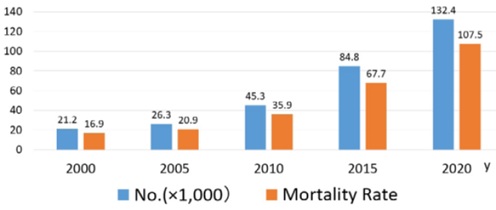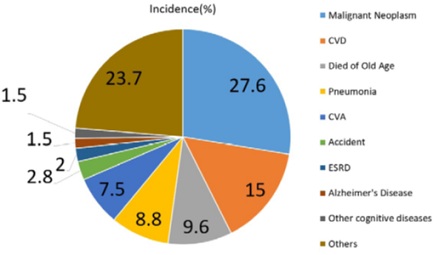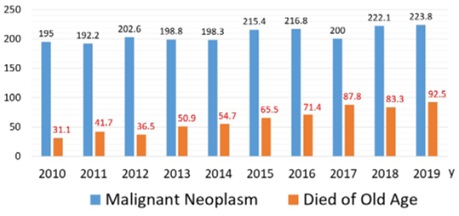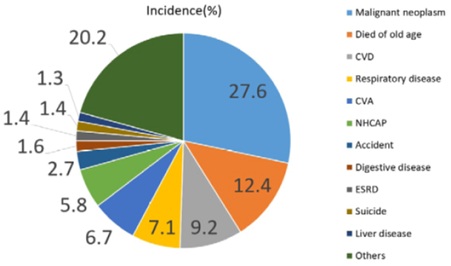
Increased Mortality of “Died of Old Age” in Japan
*Corresponding Author(s):
Yasuhiro OsugiDepartment Of Community Based Medicine, Fujita Health University, Nishiyama-cho, 3-30-1 Toyota City, Aichi Pref. T 471-0062, Japan
Tel:+81 565343000,
Fax:+81 5652841
Email:yosugi@gmail.com
Abstract
The aim of this study was to inform the significance of the mortality of “Died of old age” in older people. These categories of death (ICD R54 in Japanese modification in 2013) have rapidly increased (sixfold increase compared to 20 years before) and become the third most frequent cause of death in Japan where older people (≥65 years) are 28.6% of whole populations. In Toyota City, 24% of population is 65 years or older, the mortality of “Died of old age” showed threefold increase in the last 10 years and has become the second most prevalent next to malignant neoplasm. Physicians tend to diagnose “Died of old age” when they face patients’ death after slow and gradual progress with long-term treatment. Development of advance care planning may affect patients’ preference to die in a natural course without any intensive treatment.
Keywords
Advance care planning; ”Die of old age”; Frailty of old age; Mortality; Older people
Introduction
Japan is aging rapidly, with older population reaching 28.6% of the total [1]. Longevity has become widespread in westernized countries and Japan ran as a top-runner in these decades. Multiple comorbidity with motor or cognitive impairment is common among older people. Death in a natural course, such as succumbing to old age and multiple organ failure, is often referred to as “frailty of old age” or “senility” or “decrepitude [2].” In this study, the main cause of death in the death certificate was classified in R54 of ICD-10 (Japanese-modified in 2013). Though naming of such death creates a considerable confusion [3], “Died of old age” was preferred over others and used in this study.
Such deaths are frequently seen in hospitals, care facilities, and home health-care settings in spite of developments in modern medicines. These are assumed as natural and peaceful deaths at many instances. Even though there have been a number of discussions [3,4] or criticisms [2] that the cause of death was mistaken, underdiagnosed, or ignored, not few older people may expect such death, which would reflect an increased mortality. This study examined recent changes in Japanese mortality related to “Died of old age” in Ministry of Health, Labor, and Welfare Statistics [1], and local Health Statics Data [5].
Mortality of “Died of old age” in Japan
A sixfold increased risk was observed in the number and mortality rate of “Died of old age” by death certificate in 2000-2020 (Figure 1). “Died of old age” became the third most prevalent cause of death in 2020 (Figure 2). This was the third most common cause of death in 2018, fourth in 2017, and fifth in 2016, which indicated a rapid increase in mortality. The mortality rate of malignant neoplasm or cardiovascular disease was high similar to other western countries (the first and second most prevalent cause of death, respectively).
 Figure 1: Number and Mortality Rate of “Died of Old Age” by Death Certificate from 2000 to 2020 in Japan.
Figure 1: Number and Mortality Rate of “Died of Old Age” by Death Certificate from 2000 to 2020 in Japan.
 Figure 2: Main Causes of Death in Japan 2020.
Figure 2: Main Causes of Death in Japan 2020.
CVD; cardiovascular disease
CVA; cerebrovascular accidents
ESRD; end-stage renal disease
Mortality of “Died of old age” in Toyota city in Japan
The study was conducted in Toyota City, famous for automotive industry, to explore the cause of mortality of “Died of old age” using demographic statistics [5]. Currently, its population is 418,736, and the percentage of older people (≥65 years) is 24%. Figure 3 shows the changes of mortality rate of “Died of old age” in 2010-2019 compared with malignant neoplasm. The mortality rate of “Died of old age” was found to be increased from 31.1 to 92.5, (almost three times), while malignant neoplasm showed 1.1 time of increase. The total number of deaths increased from 2,608 to 3,188 in these 10 years (1.2 times) in Toyota City [5] compared with whole Japan, that is, from 1,197,014 to 1,381,093 (1.2 times) [1]. A consistent increase was observed in “Died of old age” both in Toyota City and Japan. Figure 4 shows 12.4% death in Toyota City is ascribed to “Died of old age,” which exceeded cardiovascular disease in 2019.
 Figure 3: The Changes in Mortality Rate of “Died of Old Age” compared with Malignant Neoplasm (C00-C97) from 2010 to 2019 in Toyota City.
Figure 3: The Changes in Mortality Rate of “Died of Old Age” compared with Malignant Neoplasm (C00-C97) from 2010 to 2019 in Toyota City.
 Figure 4: Main Causes of Death in Toyota City 2019.
Figure 4: Main Causes of Death in Toyota City 2019.
CVD; cardiovascular disease
CVA; cerebrovascular accidents
ESRD; end-stage renal disease
NHCAP; nursing and health care-associated pneumonia
Perception of general practitioners who diagnosed “Died of old Age” in death certificate [6]
Questionnaire was sent to the members of Toyota-Kamo Medical Association to collect physicians’ experiences of diagnosis of “Died of old age” and the reason for this diagnosis in 2018 [6]. Among the 120 responders in Medical Association (57.4%), 21 physicians (18%) had experienced. Table 1 shows the background whereby the diagnosis “Died of old age” was made. The highest was gradual clinical course with slow progression to death (90%), followed by “old age over 85” (62%), “chronic malnutrition with poor dietary intake” (57%), “long-term treatment over years,” and “no serious diseases or comorbidities previously diagnosed that can lead to death” (38%).
Yes: 21 (18%), No: 97 (82%) *Background whereby the diagnosis of “Died of Old Age” was made.
|
Table 1: General practitioners’ decision who diagnosed “Died of old age” in death certificates of 2018 in Toyota City.
Discussion
Not yet established universal naming of diagnosis “Die of old age” and few attentions has been paid for its significance. “Rousui” was included as an important and familiar cause of death (R54) in Japanese modification of ICD-10 (2013). Deaths in older people are seen in gradual clinical course with physiological decline, where dying older patients may look sometimes calm and peaceful. As aging society progresses in countries with higher-grade medical resources, provided that the mortality of serious diseases decreases, and longevity is expected on older people, “Die of old age” will still remain as a prevalent cause of death. Already aged society like Japan may propose a good example for these consequences.
There are several possible reasons. First, general practitioners decided or did not hesitate to certify “Died of old age (Rousui)” as a cause of death with slow and gradual progress on long-term treatment. Second, despite high-tech treatment in acute hospitals, dying older patients and their relatives are not fully satisfied with intensive cares. If they feel hopeless for living and surrounding care team fails to encourage them, they may prefer “Die of old age.” Thus, as a consequence of advance care planning [7], they may choose to “Die of old age.”Third, should modern medicine expand longevity of older people, frailty at old age will shrink their survival. That will result in similar course to death.
Fourth, emotional aspects of dying [8] or feeling of burden to relatives, physicians, or other caregivers may stimulate a natural death (die of old age). “Die of old age” is not based on pathological examination or diagnostic imaging, or other objective diagnostic procedures. It has been diagnosed mainly on slow and progressive clinical course to death judged by physicians. The diagnosis in death certificate may depend on physicians’ perception. Though the naming of “Die of old age” needs country-wide discussions, number of deaths exists in these categories that have been familiar with us. Recognition as a main cause of death should be emphasized.
Conclusion
In older people “Die of old age” is an important cause of death not only in postmortem but in prior clinical settings.
Acknowledgment
We appreciate kind collaboration of Doctors in Toyota-Kamo Medical Association in providing us Questionnaire data and thank Michihiro Matsui for data collection of local health statistics.
Conflict of Interest Statement
The authors declare that the Short Communication was processed in the absence of any commercial or financial relationships that could be construed as a potential conflict of interest.
References
- Ministry of Health, Labour and Welfare (2021) Journal of Health and Welfare Statistics 68: 400-405. Japan.
- Adhiyaman V (2021) Is it appropriate to link ‘old age’ to certain causes of death on the medical certificate of cause of death? Future Healthc J 8: e686-e688.
- Godwin TA (2005) End of life: Natural or unnatural death investigation and certification. Dis Mon 51: 218-277.
- McCue JD (1995) The naturalness of dying. JAMA 273: 1039-1043.
- Toyota City (2021) Hoken-Fukushi Report. Aichi, Japan.
- Toyota-Kamo Medical Association (2019) Annual Reports of Toyota-Kamo Medical Association: 68-70. Aichi, Japan.
- Kim H, Lee J (2020) Effects of advance care planning on end-of -life decision making: A systematic review and meta-analysis. J Hosp Palliat Care 23: 71-84.
- Yamamoto S, OsugiY, Asai K, Terasawa Y, Shi W, et al. (2017) Bereaved relatives’ perception of quality of hospital death in older patients. GGI 17: 2641-2642.
Citation: Asai K, Osugi Y (2022) Increased Mortality of “Died of Old Age” in Japan. J Gerontol Geriatr Med 8: 135.
Copyright: © 2022 Yasuhiro Osugi, et al. This is an open-access article distributed under the terms of the Creative Commons Attribution License, which permits unrestricted use, distribution, and reproduction in any medium, provided the original author and source are credited.

